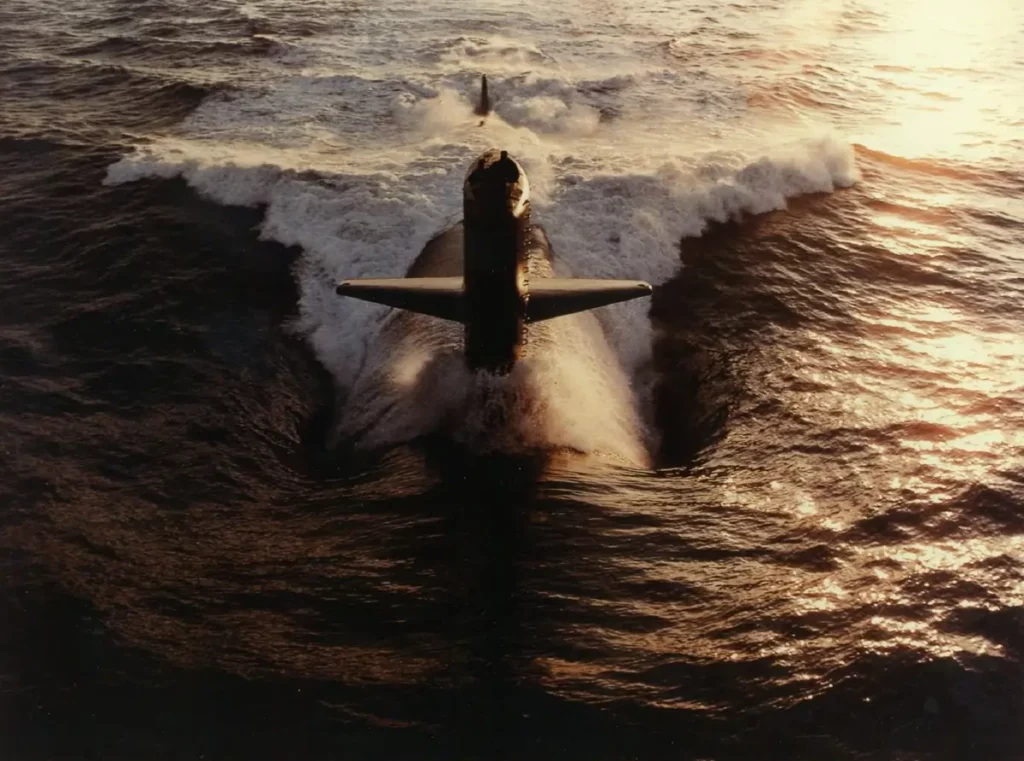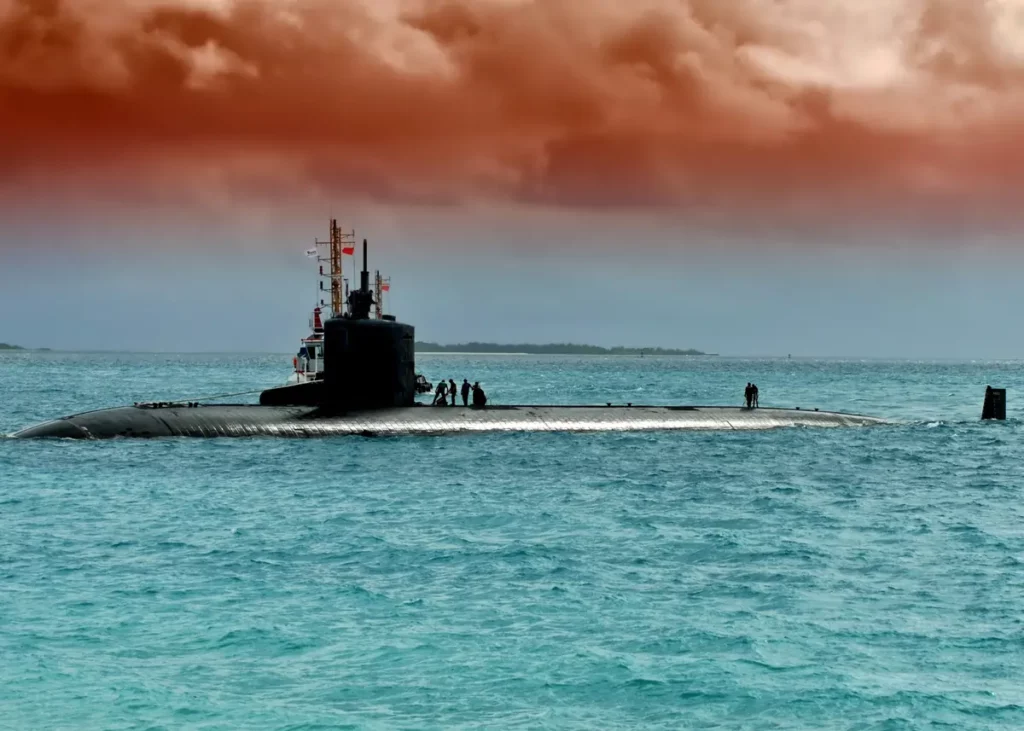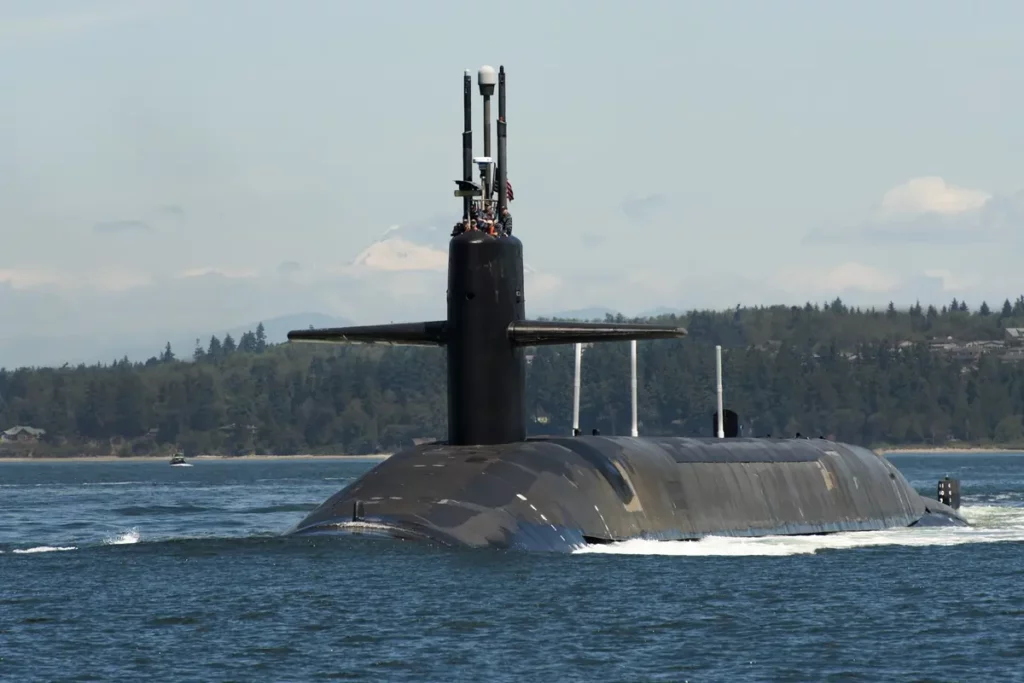Submarines are a crucial tool in modern naval warfare, as they provide an unparalleled ability to conduct stealth operations underwater. However, submarines must be able to communicate effectively with other submarines, surface ships, and shore-based facilities to be effective.
But how do submarines communicate in the underwater environment where radio waves can’t travel? In this article, we will explore the various techniques used by submarines to communicate with each other and the outside world.

How do submarines communicate with each other?
Submarines can communicate with each other in various ways, such as acoustic communication, ELF communication, and optical communication. Let’s take a closer look at these techniques:
Acoustic communication
Submarines can use acoustic communication to communicate with each other while underwater. Acoustic communication uses sound waves to transmit messages through the water.
To use acoustic communication, submarines use a device called a hydrophone to listen for other submarines. A hydrophone is a specialized microphone that is designed to detect sounds in the water. When a submarine wants to send a message, it uses a device called a transducer to convert electrical signals into sound waves that can be transmitted through the water.
The sound waves are then detected by the hydrophones on the other submarines, which can decode the message and respond using the same method. Acoustic communication can also be used to communicate with shore-based facilities by transmitting the sound waves to a receiver located on the seafloor.
Acoustic communication has several advantages over other communication methods. It is not affected by weather conditions or other environmental factors, as sound waves can travel through the water regardless of conditions. Acoustic communication is also secure, as the sound waves can only be detected by submarines or receivers that are specifically designed to receive the signals.
However, acoustic communication also has limitations. The sound waves have a limited range and can be affected by water temperature, salinity, and other factors that can affect the speed and clarity of the transmission. Additionally, acoustic communication can be vulnerable to interference from other underwater sources of noise, such as marine animals or other submarines.
ELF communication
Submarines can also use ELF (Extremely Low Frequency) communication to communicate with each other while submerged. ELF communication uses low-frequency radio waves to transmit messages through the water.
To use ELF communication, submarines generate a low-frequency radio wave that can penetrate through the water and travel long distances. These waves can travel thousands of miles through the water, making it an effective communication method for submarines that are far apart.
To receive the message, the submarine’s antenna system detects the low-frequency radio wave and decodes the message. Submarines can also use ELF communication to receive messages from shore-based facilities or other sources of communication.
ELF communication has several advantages over other communication methods. It is not affected by weather conditions or other environmental factors and can penetrate through the water regardless of the depth of the submarine. ELF communication is also secure, as the low-frequency radio waves cannot be intercepted by other submarines or sources of interference.
However, ELF communication also has limitations. The transmission rate of ELF communication is slow, and messages can take several minutes or even hours to transmit. Additionally, the equipment required to generate and detect low-frequency radio waves is large and requires a significant amount of power.
Optical communication
Submarines can also use optical communication to communicate with each other while submerged. Optical communication uses light signals to transmit messages through the water.
To use optical communication, submarines use a device called a light-emitting diode (LED) to generate a light signal that can be transmitted through the water. The light signal is then detected by the receiving submarine using a device called a photodetector.
Optical communication has several advantages over other communication methods. It is highly secure, as the light signals cannot be intercepted by other submarines or sources of interference. Optical communication also has a high transmission rate, allowing messages to be sent quickly and efficiently.
However, optical communication also has limitations. It is highly dependent on water clarity and can be affected by turbidity or other factors that can interfere with the transmission of light signals. Additionally, optical communication is limited to line-of-sight communication, meaning that the submarines must be within a certain distance of each other for the messages to be received.
Despite its limitations, optical communication is a useful method for submarines to communicate in certain situations, such as when other communication methods are compromised or when a high level of security is required.

How do submarines communicate with the surface?
Submarines can communicate with the surface using a variety of techniques, including radio communication, satellite communication, and periscope communication.
Radio communication
Submarines communicate with the surface using radio waves by deploying an antenna that is connected to the submarine’s communication system. The antenna is then raised to the surface, allowing it to establish a radio connection with the surface. The radio waves are transmitted through the air and can penetrate the water’s surface, allowing the submarine to communicate with other ships or shore-based facilities.
However, radio communication has limitations when it comes to submarines. The radio waves have a limited range underwater and can only penetrate the surface up to a certain depth. Submarines must be close to the surface to use radio communication effectively. Additionally, radio waves are susceptible to interference from environmental factors such as weather conditions and other electronic signals.
To overcome the limitations of radio communication, submarines also use other communication methods such as satellite communication and acoustic communication. Satellite communication allows submarines to establish a connection with shore-based facilities even when deep underwater. Acoustic communication, on the other hand, uses underwater sound waves to transmit messages and can be used to communicate with other submarines or shore-based facilities.
Satellite communication
Submarines use satellite communication to establish a connection with the surface and communicate with shore-based facilities. Satellite communication uses a network of orbiting satellites that relay signals between the submarine and the shore-based facilities.
To use satellite communication, submarines need to have an antenna system that can receive and transmit signals to the satellites. The antenna system is usually located on the submarine’s sail or hull and must be raised above the waterline to establish a connection with the satellite.
Once the antenna system is deployed, the submarine sends a signal to the satellite, which then relays the signal to the appropriate shore-based facility. The shore-based facility can then send a response, which is transmitted back to the satellite and then to the submarine.
Satellite communication is particularly useful for submarines because it allows them to communicate with shore-based facilities even when submarines are deep underwater. Submarines can use satellite communication to receive important information such as weather reports, navigation data, and mission updates. They can also use satellite communication to transmit information such as status reports, intelligence data, and other critical information.
While satellite communication is a reliable way for submarines to communicate with the surface, it does have limitations. Satellites are susceptible to interference from solar flares, electromagnetic pulses, and other sources of radiation. Additionally, satellite communication can be affected by weather conditions and other environmental factors that can degrade the quality of the signal.
Periscope communication
Submarines can also use periscope communication to communicate with the surface. A periscope is a device that allows a submarine to view the surface while it is submerged. It consists of a series of mirrors that reflect light, allowing the submarine to see objects above the waterline.
In periscope communication, the submarine raises its periscope above the waterline, and a signal lamp is attached to the periscope. The signal lamp is used to transmit Morse code signals to other ships or shore-based facilities.
To send a message, the submarine operator turns the signal lamp on and off, creating a series of dots and dashes that represent letters and numbers. The Morse code signals are then received by the intended recipient, who decodes the message and sends a response.
Periscope communication has limitations compared to other communication methods, as it requires the submarine to be close to the surface and exposes the submarine to detection by other ships or aircraft. Additionally, periscope communication is a relatively slow communication method, as Morse code messages are transmitted one letter at a time.
Despite its limitations, periscope communication can be a useful method for submarines to communicate when other communication methods are unavailable or compromised.

How do submarines communicate with shore-based facilities?
Submarines can communicate with shore-based facilities using satellite communication, radio communication, or acoustic communication.
Satellite communication
Submarines can use satellite communication to transmit messages to shore-based facilities. They use a communication buoy, which is released to the surface, to transmit messages to satellites. These messages are
then relayed to shore-based facilities.
Radio communication
Submarines can use radio communication to transmit messages to shore-based facilities. They use high-frequency radio waves that can penetrate the water’s surface and reach shore-based facilities. However, the range of radio communication is limited underwater and requires the submarine to be close to the surface.
Acoustic communication
Submarines can use acoustic communication to transmit messages to shore-based facilities. They use underwater sound waves to transmit messages to hydrophones located near the shore. These messages are then relayed to shore-based facilities.
Conclusion:
Submarines are essential for underwater operations, and communication is critical to their success. Submarines use various communication techniques to communicate with each other and the outside world, such as acoustic communication, ELF communication, optical communication, radio communication, satellite communication, and periscope communication.
By using these communication techniques, submarines can conduct stealth operations underwater while maintaining contact with other submarines, surface ships, and shore-based facilities.
- Types of Gas Carriers as per IGC Code – April 22, 2025
- Wind-Assisted Propulsion Systems (WAPS): A Game Changer for Maritime Decarbonization – February 6, 2025
- 10 Boat Salvage Yards in California – January 25, 2025



